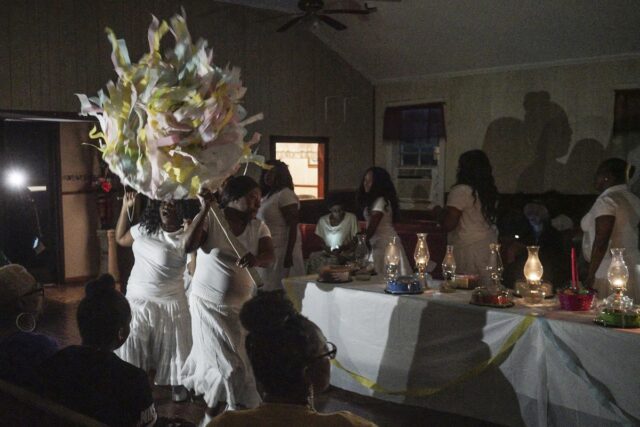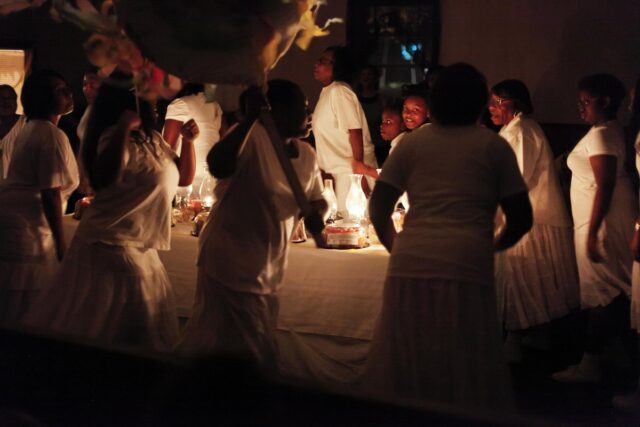Rockin’ to a Risen Savior
The Louisiana Delta Easter Rock
Published: September 1, 2020
Last Updated: March 22, 2023

Photo by Peter Jones
At the song service and devotional preceding the Rock, mistress of Ceremonies Katie Matthews (in pulpit) welcomes special guest Barbara Foy during the 2015 Rock.
The Winnsboro Easter Rock includes extended family and friends led by Hattie Addison Burkhalter, who learned the tradition from her mother, Ellen Addison. Burkhalter has had support from her daughter, Laketa “PK” Levy, and her late husband, Booker T. Bookhalter, who died two years ago at age 104. By 2010, the church building needed so many repairs that the Rock was held in other venues (an American Legion Hall, a community center, a new church, and a theater) until repairs were completed in 2015. In spite of these problems, as well as the losses of her mother and husband, Burkhalter continued to hold the Rock until this year’s COVID-19 restrictions on large gatherings prohibited the ritual.
While Easter Rock now lasts from 7:00–10:00 p.m. instead of the whole night, the pattern of the Winnsboro Easter Rock remains comparable to those documented in nearby Concordia Parish. The interior of the church is reorganized, with the pews moved perpendicular to the pulpit flanking a center aisle with a long table covered with a white cloth—the Rock’s focal point, representing the sepulcher of Christ. The service opens with a devotional, consisting of an a cappella congregational hymn—often a call-and-response Dr. Watts song—followed by a scripture reading, an inspired prayer, and a congregational hymn. A mistress of ceremonies, recently Katie Matthews, presides over the program and provides spirit-filled messages and support for music performers, including a variety of vocal solos and groups, mostly unaccompanied. In the 1990s gospel bands sometimes performed, and from 2011 to 2015 Winnsboro native Robert Finley, a finalist in the 2019 season of America’s Got Talent, provided electric guitar back-up for singers. The spirit-filled musical performances heighten the emotions in preparation for the symbol-laden Easter Rock.
Reading from the paper program, the mistress of ceremonies announces that the “Rockers are in charge.” As a member of the Rock sings the opening lines of another Dr. Watts hymn, lights are dimmed, and women dressed in white gather at the door. The women echo the Biblical parable of the wise and foolish virgins and the women who visited Christ’s tomb. In earlier days, the women wore white Sunday attire; today the women wear white skirts, shirts, and tennis shoes. Sometimes, a young man in a white shirt may participate. The white attire sets the rockers apart and symbolizes purity, innocence, and death.
The women, bearing lighted oil lamps, march slowly into the dimly lit sanctuary up to and then circling the table, singing “When the Saints Go Marching In” at a funereal tempo. The aptly chosen song reflects their joining Christ in his death as they approach the sepulcher: “Oh Lord, I want to be in that number when the saints go marching in.” The lamps, according to Hattie and Ellen Addison, represent the twelve tribes of Israel. After the first circle around the table each woman is given one of twelve cakes representing the twelve disciples, along with containers of red punch to place on the table. Burkhalter says the cake and punch symbolize the body and blood of Christ as they do in communion. Then the leader takes the banner—a four-foot pole topped with a flat disk covered with white material and multi-colored crepe paper streamers. The banner symbolizes Christ’s cross or Moses’s staff and also echoes banners carried in West African funeral processions.
Counterclockwise circling the table, the Rockers move into a call-and-response song, led by caller Emma Hagan—“O, David,” telling the story of David’s overcoming Goliath with a rock. The Rockers’ shuffle steps echo the rhythms of African drums on the wood floor while they sing “The Lord’s Prayer” until exhausted. The singing procession is joyous because, as Burkhalter says, they are celebrating the resurrection by “rockin’ to a risen savior.” As for the use of the term “rock,” Ellen Addison cited a biblical source: “Elijah rocked to the coming of the Lord.” “Rocking” reflects the side-to-side movement of the Rockers and the banner. Ellen Addison describes the rock step: “Move your foot from one side to another, but you ain’t supposed to cross your legs. . . . They say you’re dancing when you cross your legs.”
While they rest, more singers perform, and an offering is taken. Then the Rockers resume, and finally members of the congregation may join them. The Rock always closes with the Rockers chanting, “I think I’ll go on home back to my Father’s house” as they exit. The service closes with remarks and prayer, followed by the Rockers serving the symbolic cakes and punch to the congregation in a happy reunion atmosphere.
Acknowledgements: Thanks to Hattie Addison Burkhalter for her efforts to keep the Easter Rock alive and share it with others. She welcomed our documentary efforts and has worked to present the Rock at national and state folklife festivals. Other members of the Winnsboro Easter Rock Ensemble over the years include Ellen Addison, Booker T. Burkhalter, Sheretta Dunbar, Jimmie Lee Jones, Laketa Addison, Jessie White, Ashley Winn, Britney Cook, Christy Cook, Azzie Lee Jackson, Lionel Wilson, Lillie Carter, Nikiya Pleasant, Emma Jones Bradshaw, Kelly Brown, Felicia Brown, LaDejia Addison, Ha’Tia Levy, Tyreal Addison, Jada Robinson, Yazmine Pleasant, Tammy Lynch, Karen Whitfield, Jeria Brown, Jalissa Brown, Roderick Levy Jr., D. J. Johnson, Tyron Williams, Sherell Addison, Tomeka Cook, Nikki Smith, Deadrea Marzell, John White, and callers Jimmy Brown, Fred Ross, Beulah Ross, and Emma Hagan.
Dr. Susan Roach, the Mildred Saunders Adams Endowed Professor in English, serves as director of the School of Literature and Language at Louisiana Tech University. Holding a PhD in folklore from the University of Texas at Austin, she was folklorist for the Louisiana Regional Folklife Program at Louisiana Tech University from 1998–2009, and continues fieldwork on north Louisiana folklife. She received the Louisiana Endowment for the Humanities Lifetime Achievement in the Humanities Award in 2015.


